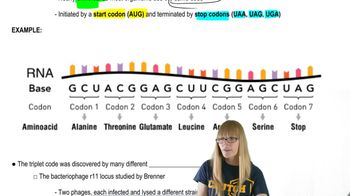Here are the essential concepts you must grasp in order to answer the question correctly.
Template and Nontemplate Strands
In DNA, the template strand is the one that serves as a guide for RNA synthesis during transcription, while the nontemplate strand, also known as the coding strand, has the same sequence as the RNA produced (except for thymine being replaced by uracil). Understanding which strand is which is crucial for interpreting sequencing data, as it determines the direction of transcription and the corresponding amino acid sequence.
Recommended video:
Dideoxynucleotide Sequencing
Dideoxynucleotide sequencing, or Sanger sequencing, is a method used to determine the nucleotide sequence of DNA. It involves incorporating dideoxynucleotides, which terminate DNA strand elongation, allowing for the generation of fragments of varying lengths that can be separated by gel electrophoresis. This technique is essential for analyzing the specific sequences of both wild-type and mutant DNA segments.
Recommended video:
Codons and Start Codon
Codons are sequences of three nucleotides in mRNA that correspond to specific amino acids during protein synthesis. The start codon, typically AUG, signals the beginning of translation and is crucial for the correct assembly of the protein. Identifying the start codon and subsequent codons in the sequenced DNA is vital for understanding the functional implications of mutations in the protein-coding region.
Recommended video:
 Verified step by step guidance
Verified step by step guidance Verified video answer for a similar problem:
Verified video answer for a similar problem:



 7:40m
7:40m